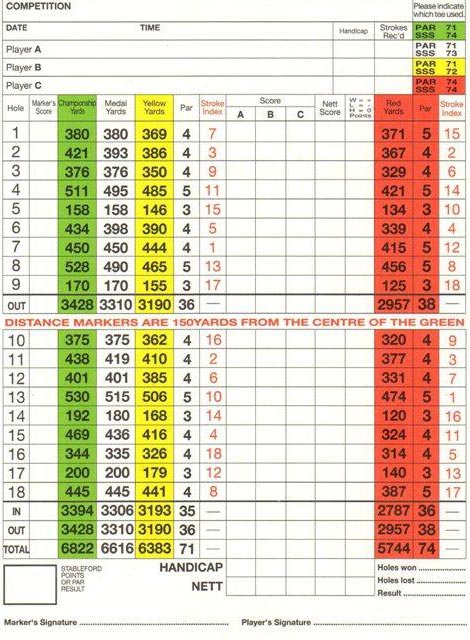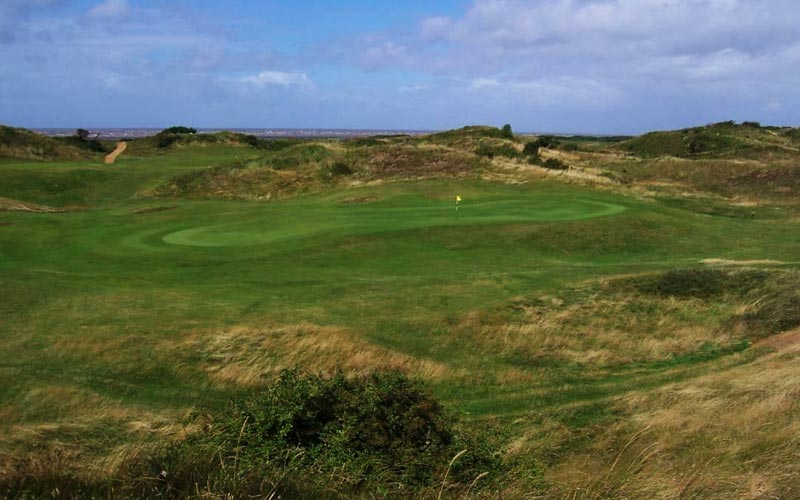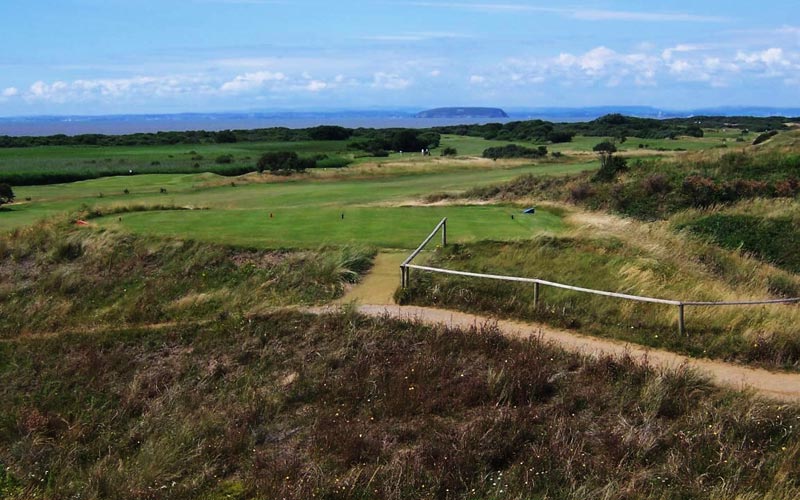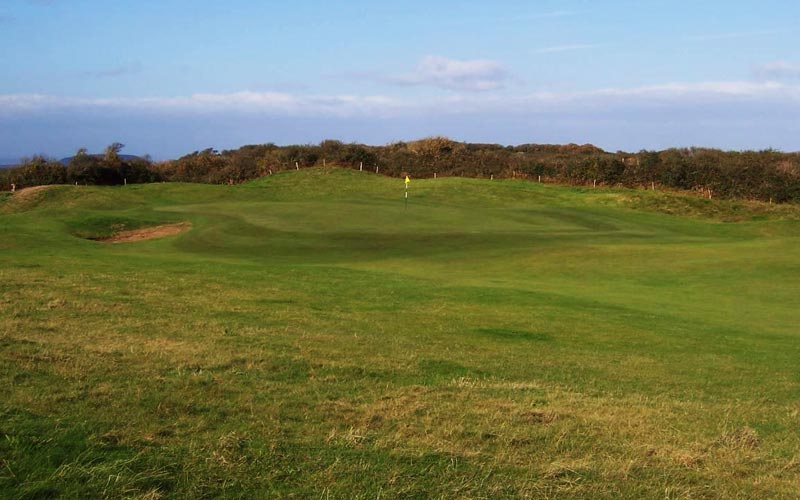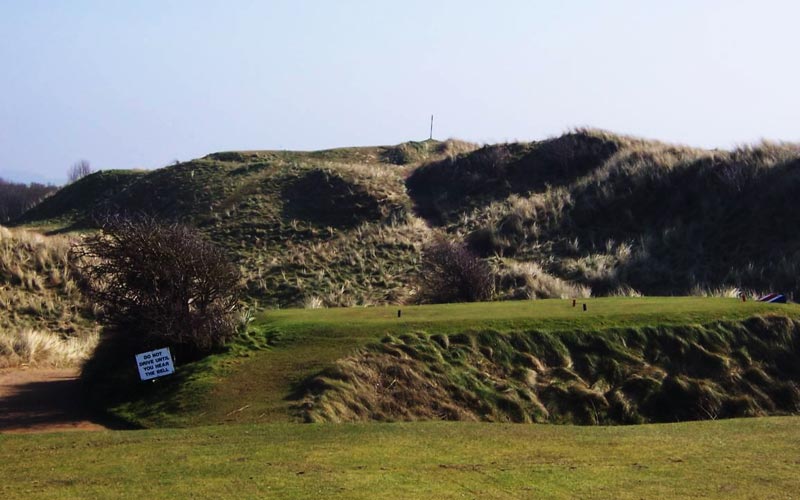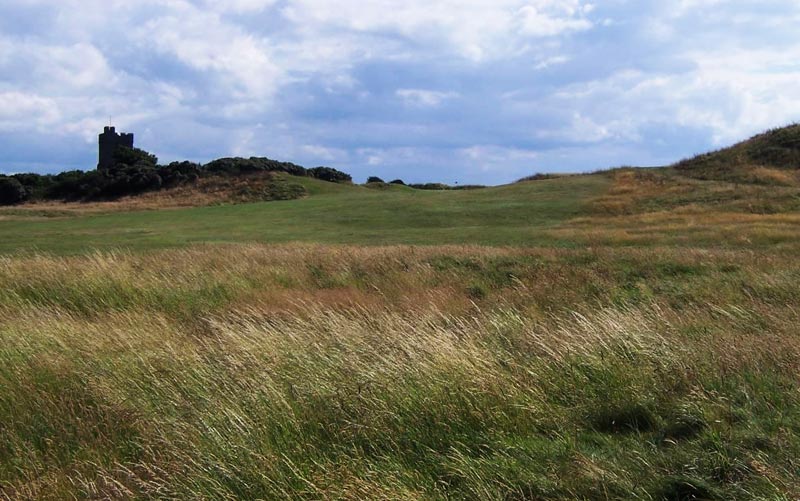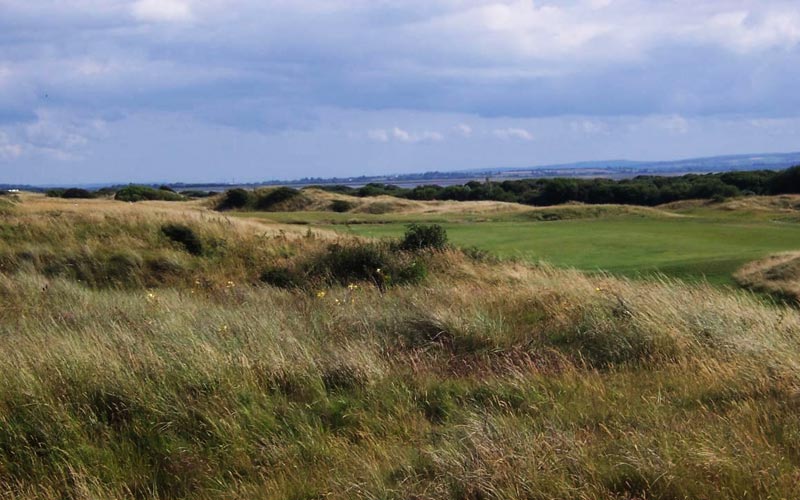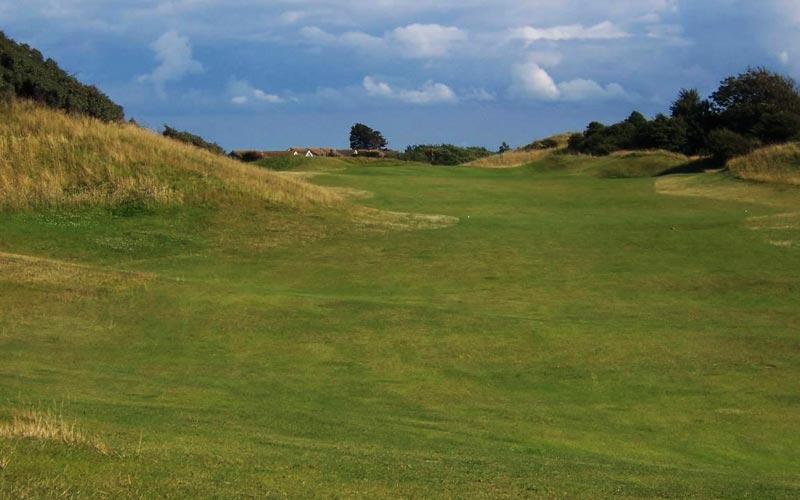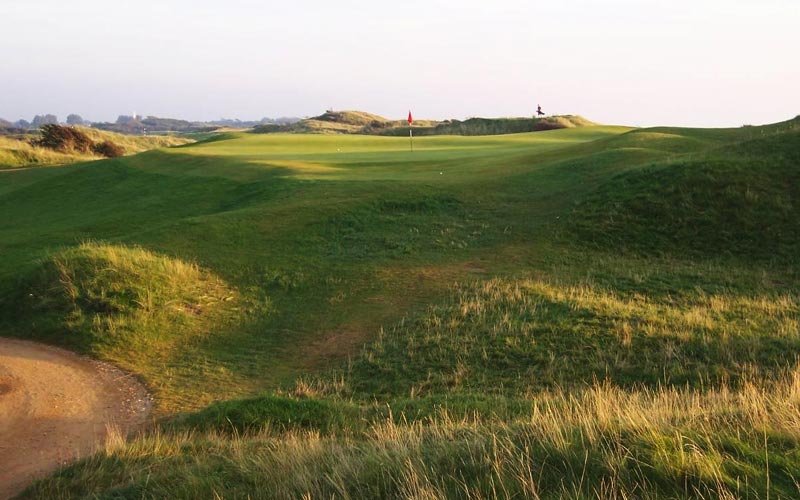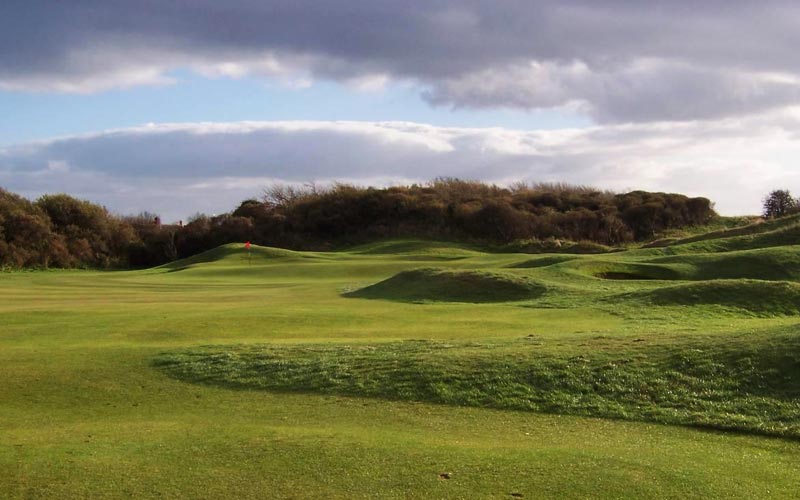Golfing the Warren – Burnham & Berrow Golf Club
by Sean Arble, February 2010
H. S. Colt is often cited as the creator of Burnham and Berrow and rightly so. Colt’s blue print used the natural contours of the land tellingly in creating eight new holes and is largely responsible for the reputation Burnham enjoys today. However, Burnham’s story doesn’t begin with Colt as the club was well known prior to his arrival. As Burnham was in constant flux during a period in history when the Haskell ball was introduced and golf was booming, the course makes for a fascinating study in architectural development.
In 1891, Charles Gibson, the professional of Royal North Devon GC, laid out the first 9 hole iteration of the course not far from the Burnham lighthouse. Nine additional holes were built in 1897 creating a course which featured a number of short, blind holes. ‘Whenever a golfing conversation turns upon blind holes, and one party boasts of the giant sand hills and deep valleys of any particular course, it is almost certain that another will say, Ah, but you should just see Burnham in Somerset’ is how Bernard Darwin described the course in The Golf Courses of the British Isles.
Based on the recommendation of Gibson, the club appointed a little known teenager from Northam Working Men’s GC whose membership played over the links of Westward Ho!. That man, J. H. Taylor, would later win five Open titles, the first of which was in 1894, and become forever celebrated as a member of the Great Triumvirate along with Harry Vardon and James Braid. J.H. also captained the victorious 1933 Ryder Cup team and was a founding member of the Professional Golfer’s Association. Taylor returned to Burnham on many an occasion for exhibition matches and in 1901 he altered the course by creating holes beyond Berrow Church. Burnham quickly gained a reputation for excellence and in 1906 was thought worthy to host both the Ladies British Open Amateur Championship and the Ladies Home Internationals. The club looked inward for its next round of changes. Former Captain of the club, Herbert Fowler, was engaged to extend the course in 1910. While little of Gibson, Taylor & Fowler remain, these remnants are significant in terms of retaining some of the early charm for which Burnham is justly famous.
Well before Colt’s 1913 plan was completed, Herbert Fowler was approached for further advice as was Harold Hilton and Dr Alister MacKenzie; though it isn’t clear if any of their suggestions were acted upon. More significantly, Hugh Alison, a Past Captain and long time member of Burnham & Berrow, not only contributed with direct design input over the course of nearly two decades, but as a close partner of Colt, it is likely that he had input into Colt’s Plans of 1913 & 1925 and probably oversaw the progress of the changes.
Burnham’s endurance as a venue for amateur championships has lasted more than a century. In addition to hosting the Ladies British Open Amateur Championship, Ladies Home Internationals and English Ladies Championship on several occasions, the club has been the venue for many English Amateur Championship (most recently in 2006), the Brabazon Trophy (to be hosted again in 2011) and the Home Internationals. Burnham is also the permanent home for the West of England Winter Foursomes and the West of England Open Amateur Championship. The Winter Foursomes is unusual in that a high marker can find himself (or herself!) shaking hands with professionals on the first tee. Indeed, professionals regularly enter the competition and luminaries such as Peter Alliss and Brian Barnes have claimed the handsome trophy.
There are six main factors which, when taken as a whole, makes Burnham richly varied and distinctive among the best links of England.
- Burnham is rare in that one can often feel cocooned amongst the dunes, yet the course has no less than seven holes which offer alternate tees. These tees create significantly different angles, but with a minimal increase in yardage. Additionally, the balance created by width in tees is remarkable; five holes turn left, four holes turn right and four holes can play either way. This is no small matter when one considers the inherent limitations of Burnham’s out and back design.
- Like The Old Course, Burnham strongly favours an aerial approach for all of its one- shotters. Colt was keen on using plateaus for par 3s and he did so to excellent effect at Burnham. Each short hole has a sharp rise to the front making club selection a critical factor. This style of design was to influence many later architects as the aerial game became more prominent.
- There is an interesting mixture of architectural styles which is most obvious when viewing the green sites. The Hawtree and Pennink greens tend to be on plateaus which have severe run-off on most sides. The pre-Colt greens are either bowl/collecting greens or greens which run front to back. Colt’s varied styles of greens help to produce a seamless layout.
- Burnham is somewhat unusual for a course of its stature in that it doesn’t rely heavily on bunkers in the same way most championship links do. In fact, the bunkering could be considered fairly light. There are two holes with one bunker and four without any sand at all. Much of the challenge is provided by a balance of testing lies found in the bumps and hollows as well as rough, wind and width from the tee.
- Despite its traditional out and back nature, the routing takes the golfer on a journey filled with surprises. The course commences in the dunes with six classic links holes, all of which are attractive and require some playing to score well. The 4th offers splendid views of the Bristol Channel with the often hazy expanse of Wales in the distance and the island of Steep Holm in the foreground. The course then becomes flatter for the holes around the turn. This section is broken up by the marvelous short 9th and the curious blind drive over a huge dune on #10. When the golfer begins to wonder where that fine dune country viewed from various places on the course is, he finds himself in it once again upon hitting the approach to the Church hole, #12. This admirable golfing country continues with compelling shots highlighting play until the player doffs his cap on the 18th.
- Similar to the links of Rye, Burnham’s holes are so arranged that the prevailing wind coming varyingly from the southwest or northwest is nearly always blowing across the golfer. On but a few holes does the player gain the advantage of a straightforward shot to play with a head or tailwind. For most the relentless crosswinds are a source of failure and disenchantment, but for the surgeon like player who is able cut and hold shots as the wind demands, Burnham must seem a playground full of joy.
Similar to Royal Aberdeen and Prestwick, the golfer is on full display and likely under scrutiny while standing on the 1st tee, for it is located directly in front of the clubhouse windows. Added to this bit of worry is the sight of the opening hole, a moderate length two-shotter which plays down an alley of dunes. The hand of Colt is immediately apparent as he cut a cruelly narrow gap in a crossing dune some 90 yards short of the green, allowing the golfer to see his ultimate target. First, however, the player must find the fairway dead in front of him or hidden slightly to the right. There is no immediate difficulty for avoiding the white knuckle play down the middle close to possible disaster on the left. However and as is the case with many great holes, the situation becomes fully apparent when the golfer finds his lack of conviction on the previous shot leaves a troubling second. In the case of the opener the difficulties in question are blindness, poor angle of approach and most probably an awkward lie.
The 2nd is a devil of a par four. The player will hope to run through a large dip in the centre of the fairway, but if he chooses this bold play he must also shape the tee shot right to left into the crosswinds off the Channel as the fairway turns left just enough to cause concern. Depending on the wind and one’s abilities, it may be safer to hit for the dip and accept that more often than not, the approach will be blind.
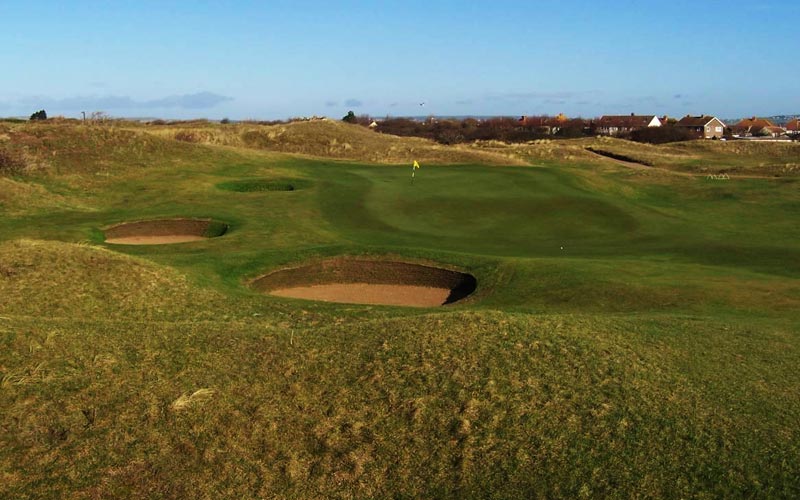
The approach to the long, narrow, two tier green is guarded by bunkers up the left and by a steep drop-off right. Many members finding themselves right of the green pull out the putter without giving it a second thought.
#3 is a delightfully old fashioned hole. Due to WWI and other considerations, Colt’s 1913 plan wasn’t fully implemented until 1936. The new layout largely eliminated the blind aspects of the course, but not without some degree of resistance. In particular, many members were aggrieved by the loss of Majuba, one of Bernard Darwin’s favourite blind holes. The 3rd tee rests on the hill which gave the hole its name. The once famous hole was named for a decisive battle in which the Boers inflicted a resounding defeat on the British occupying Majuba Hill. The original hole played from somewhere quite close to the current 16th green, over a significantly higher Majuba than today in an east-west direction toward an area of humps and hollows in the current 2nd fairway. Not many years later, in 1900, Majuba was altered to play in a north-south direction as the 17th does today. To play a shot some 200 yards up and over an approximately 50 foot high hill would have been a most formidable task that the members seemed to relish.
As was hinted at above, Majuba was leveled somewhat to allow for what eventually became the tee for #s 3 & 17. The drive for the third is downhill and must find a narrow fairway which runs at an angle to the tee.
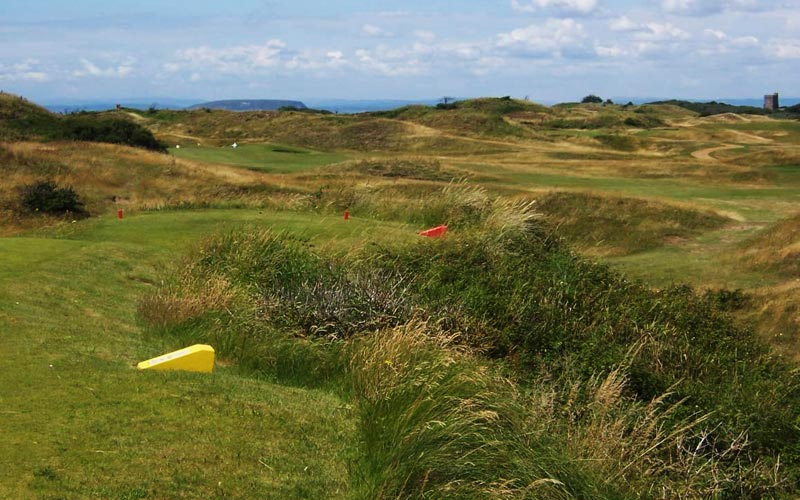
The player has the option of playing safely right or boldly to the left over a pair of hidden bunkers online with the far bunker.

This photo, taken from the lower tee on #17, used to be the Medal tee for #3 in years past. It offers a glimpse into Burnham’s sporty days of old when blind shots were as common as bogeys.
The approach is to a punchbowl green cradled in a bed of dunes with a unique feature; just short of the green are two hollows. Most players choose to carry these hollows rather than run the risk of being left with a tricky downhill chip if the running approach comes up short. Either way one chooses to play the hole the ultimate result is in the hands of chance.
The 4th continues the theme of offering the player choices from the tee. Like the 3rd, the fairway is well below the tee and shoots across the line of play rather than cozying up to the tee; only this time the hole turns right. Even for moderate length hitters, the green for this short par 5 is often reachable in two during summer months if the player hits a well judged drive.
At 158 yards from the back blocks, #5 was the shortest hole on the course and deceptively difficult with its raised putting surface being fairly small and hidden pot bunkers guarding front, left and right. Recently, the championship tee was moved back to a tee platform used for the Channel Course. The hole now measures 201 yards and in combination with the extra 30 yards on the 15th, this is the most significant increase in yardage to the course in three decades. In addition to these increases, new tees on #s 10, 13 & 16 are to be built during the winter months of 2009/10. The total yardage for the 2011 Brabazon Trophy , which Burnham will host, should measure close to 6950 yards.
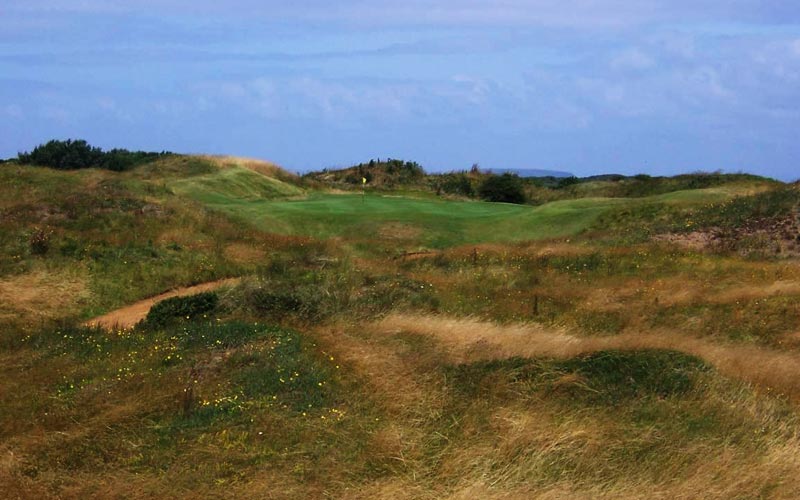
Five is one of the few holes in which the dunes act as cover from the troubling wind coming off the left. Consequently, many hit over the left dunes only to be disappointed with the result.
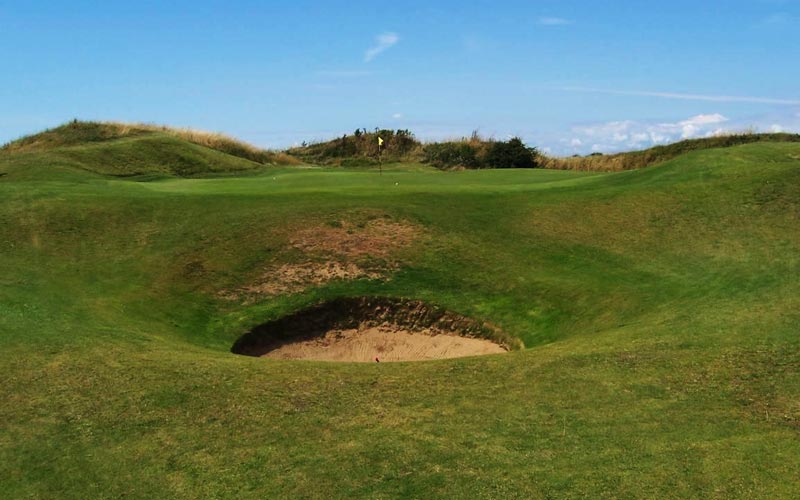
As is the case with many links, bunkers can be hidden with the land unmistakably drawing toward them.
Judging by how often the course has been altered, it is difficult to accuse the members of having a resistance to change. However, the most recent changes to Burnham’s 6th are controversial to say the least. The revised hole, completed around 2003, is much more exacting than its predecessor. Martin Hawtree, retaining his father’s shape for the hole which was completed in 1976, did some minor alterations with the area left of the fairway at the turn of a dogleg left, around broken ground. On previous holes it was the angle of the fairway to the tee or a natural obstacle which created the interest off the tee. The sixth is the first of several holes around the turn in which the choice of tee dramatically alters the look, feel and playing consideration of the holes.
The hotly debated feature of the 6th is the green. Mr. Hawtree created a severe putting surface which falls away from the centre of the green on all sides. Many claim the green is a bit too demanding, especially given the sort of winds that frequently rake this part of the coast. The green is testing, but unless one misses in the bunker left, there is ample opportunity for a well laid chip and putt for par. Before heading down the sandy path to #7 the golfer should pause a moment and take in the WWII bunker off the left of the fairway and perhaps spare a kindly thought for all those who sacrificed so much defending the borders of Great Britain.
We now arrive at the marshy part of the course. The flat holes around the turn are sometimes viewed as less than satisfactory. The criticism concerning the somewhat boggy nature of the 7th & 8th due to a high water table is understandable. Yet, taken as a group, these holes are full of interest and a welcome contrast to those running through the dunes.
The 7th is as Bernard Darwin used to say “a hole of alarming excellenceâ€. A spine extends from not far in front of the tee right through the green. A bunker tucked under the fold of the ridge is the player’s main concern off the tee. This bunker, together with the hole location dictates the strategy off the tee. There probably isn’t another hole at Burnham which is so defined by such seemingly innocent features. An added virtue is the green which flows toward the water on the right. In this age of ‘bolder is better’ the subtlety of using simple ground features to create the interest is fast becoming a lost art.
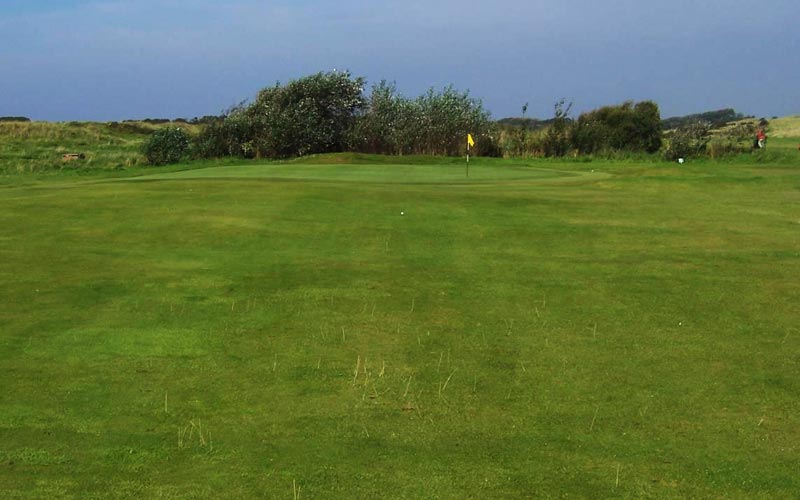
A closer look at the 7th green demonstrates how the spine flowing into the left side of the green influences play.
Some 90 yards were added to the 8th when Alison planned to move the green to its present position. The work was completed in 1953, one year after Alison’s death. As such this is likely one of his last undertakings in course design. Similar to #s 6 & 7, the 8th also has two teeing areas. The difference with this reachable par 5 is the two sets are at least 100 yards apart. The contrast is so striking that the hole can play either as a dogleg left or a dogleg right over water. Both versions are good, though because the right tee creates a clear distinction in strategy from the previous hole, many believe it has more merit.
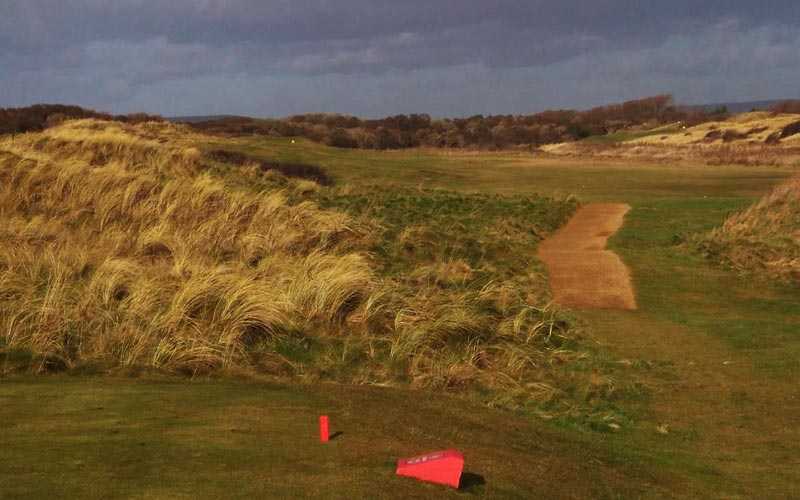
Number eight from the lower left tee. The brown area left of the path and right of the distant flag is the nearest of the three new bunkers.

As this photo from the right tee demonstrates, this latest bunker work significantly tightens the drive on #8.
Every par 5 at Burnham is reachable in two, but all have elements of risk in trying to achieve a two putt birdie. In November 2008 three bunkers were added down the left of the 8th fairway which will likely unnerve the player who is fearful of a left to right wind. Many will now entertain thoughts of laying up off the tee. The successfully bold driver faces as good an approach as one is likely to find anywhere. A pawkishly placed bunker approximately 40 yards shy of the green was built in time for the 1963 English Amateur. Michael Bonallack freely admitted to stealing this championship from Alan Thirwell by getting up and down some 22 times during the finals of their 36 hole match. This lone pit is all the protection the green requires. More often than not players going for the green in two hedge their bets in staying clear of the bunker with the predictable result of the ball scurrying down the right flank of the green.
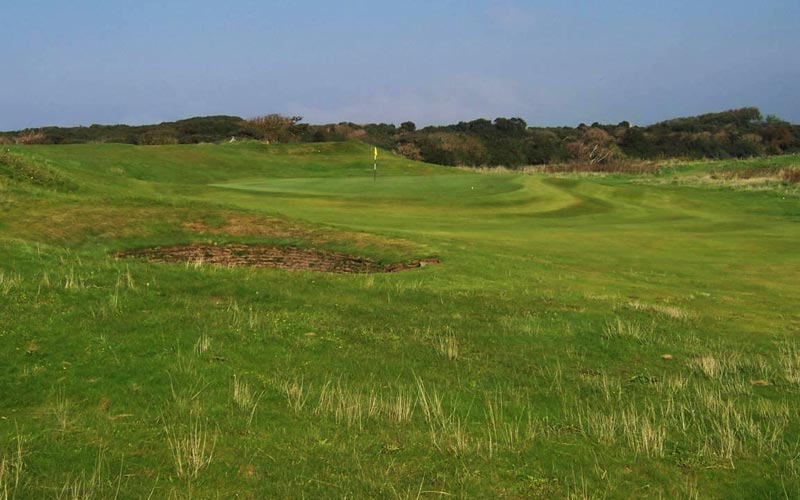
Alison moved this green just below and right of the 9th tee. The drop-off on the right created by this new site often finds unwitting victims.
With the marshy holes behind us, players now encounter another short hole, the 9th. Though the green looks well defended, it isn’t nearly as testing as the other par 3s. A short iron is often all that is required to reach the green. Unusual for Burnham, #9 offers a sliver of daylight between the fronting bunkers. One can try to bounce a flat shot between the sandy pits and it can be occasionally advantageous to do so if there is a strong tailwind.
Considering one of Colt’s objectives at Burnham was to eliminate blind shots, the turn for home is most curious. Approximately 175 yards of rough country over an imposing dune must be cleared to reach the 10th fairway. However, given the endless range of grand dunes and the history of sporty golf at Burnham, it would be unthinkable not to have one blind hole which demands the golfer hit it high if not so far. Before Colt’s revisions this sort of hole was de rigueur at Burnham and Darwin seemed to take particular delight in attempting the required heroic carries. ‘It is the modern fashion to despise sandhills, but if you come to Burnham to scoff at them you will remain to pray that the wind will not blow so strongly in your teeth that you cannot get over. These hills revive some of the ancient joys and sorrows of the gutty era, when you were quite simply and naturally pleased with yourself for having hit the ball far enough and high enough. I really do not think that there is any other course which on a windy day gives so much zest to life by its tee shots.’
There is another peculiarity concerning this hole; the green site. Many a golfer may wonder why the current flat area for the green was chosen when there is a range of unused dunes a mere 50 yards to the right. Perhaps Colt thought it a step too far in expecting the golfer to blindly hit the optimum spot in the fairway which would enable the golfer to see the target. It is likely we shall never discover why this decision was taken, however, the current green site has more about it than is immediately apparent. Colt used the out of bounds down the left to great effect. One must challenge the boundary fence and adjacent rough to gain the best angle of approach to a green which slopes away from the player. Playing cautiously to the right of the fairway leaves an obscured approach over a green side bunker.
The 11th is another hole which has the advantage of very different teeing areas some 60 yards apart with the far right tee turning the hole from a fairly straight one to a dogleg right. This hole is similar to the 6th in that the driving area is not readily detectable. A lone fairway bunker awaits on the left. The green hugs the floor perfectly, a majestic example of grade level design. Well placed bunkering ensures that the proper angle of play is rewarded. The two bunkers short and right of the green were pushed further to the centre of the fairway in November 2008. The effect of which was to constrict the ground option gap to approximately 15 yards of width.
Burnham’s story of change continues on the following trio of holes. Because Berrow Church was problematical in terms of playing on Sunday, in 1972, the club decided that change was necessary. It isn’t quite clear why this was the case, but F W Hawtree was responsible for the 12th & 13th and F Pennink for the 14th. The work around the church was completed in 1978 and despite the loss of the much loved Old Mill hole; the new course configuration is deemed a great success.
The 12th signals the start of one of the great finishing run of holes in England. This brilliantly difficult 401 yard hole takes us straight past the previous green, turns gently right and rises back into the dune country. The eye seems to suggest that keeping right is a sly play, but the angle of the dogleg dictates that the centre of the fairway is more prudent. The green lies quite near Berrow Church and is difficult to hold no matter which club one approaches with. Just shy of the green there is a large dip which forces the player to make the decision of carrying the plateau green or running an approach through the hollow. Needless to say, most fours are earned with an up and down.
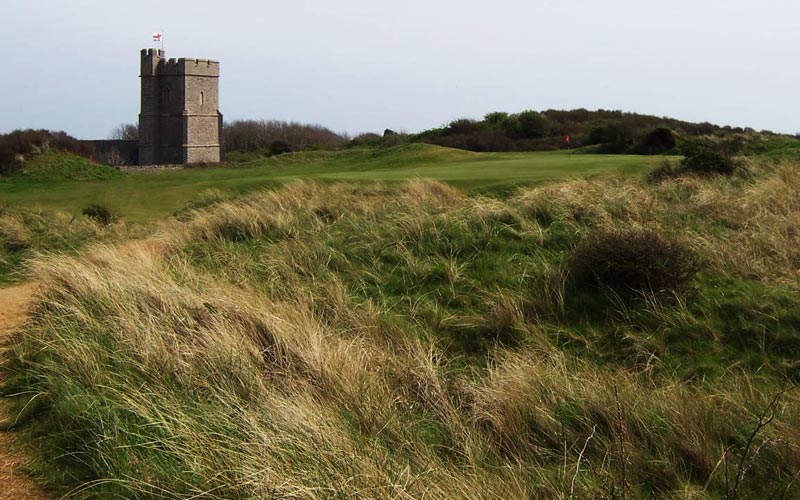
The 12th green with Berrow Church flying the Cross of St George in the background. Also evident is the scale of the dip short of the green.
On many great strategic holes, the player must decide on the tee what his ambitions are, the 13th is one such hole. Should the sandy trodden bridleway to the beach be carried, the player is often rewarded with a full view of the green and an opportunity to get home in two. If the player chooses to lay up off the tee, it is an odds on bet he will choose to play the more often than not blind second conservatively as well.
Once safely over the bridleway, this three-shotter continues winding its way through the dunes to a green which falls deceptively hard toward perdition on the right. If Burnham has a weakness it lies in the double edged sword of its dunes. These hills provide charm, interest and beauty for the golfer, but they also constrict the field of play. Sometimes the golfer can lose a ball 5-10 yards off the fairway or find himself in a near impossible position on the slopes of rough clad dunes.
The 14th is the last of the newer holes and perhaps the most demanding of Burnham’s par 3s. Many golfers opine that the hole plays rather awkwardly. This may be due in part to the green site being originally designed to receive a shot from fifteen’s left tee.
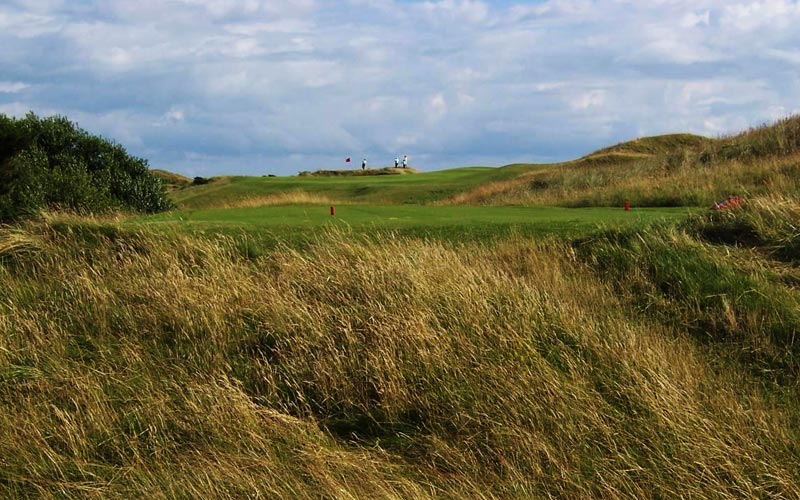
The uphill nature of the 14th makes it imperative to control ball flight. The golfers in the background are on the #15 tee.
Much admired and hard to imagine being built in this day and age, the 15th is one of Burnham’s more idiosyncratic holes primarily for two reasons. First, the fairway runs hard against the course boundary to the left, yet the best angle of approach is from the right rough in or near a large hollow named the Kitchen. Beyond the Kitchen the fairway ripples with undulations into a dell where the green lies. Second, the tees are divided by four dozen yards creating entirely different angles. Additionally, in December 2008, an old tee some 30 yards behind the left tee was reinstated.
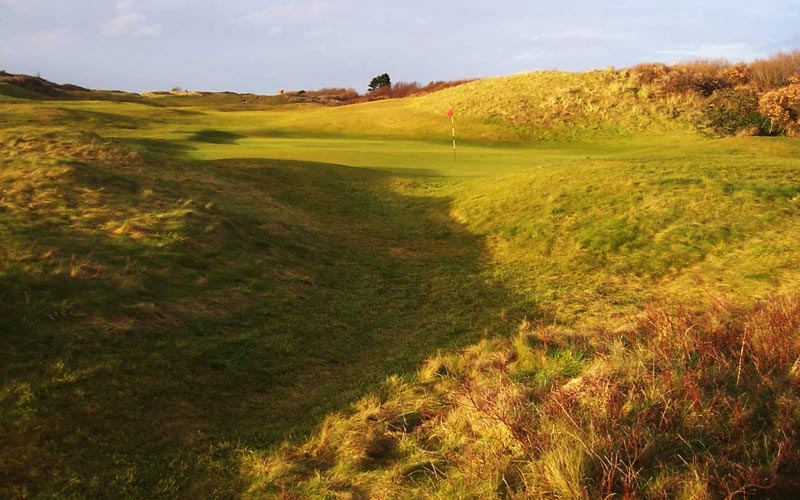
From behind the 15th one can see how the dune partially blocks access to the left side (right as seen in the photo) of the green.
Many great golf courses have at least one drivable par 4 and perhaps this is one architectural element Burnham is lacking. There are two short par 4 candidates which are certainly within reach for the longest of hitters, but neither the 3rd or the 16th offer a tee which allows the player of more modest capabilities to have a go at one of the most thrilling shots in golf; taking aim at a two-shotter with the intention of putting for eagle. As it is, this 344 yarder is often seen as a bit of a drive and pitch breather. Yet, as is the case with every hole at this Somerset gem, there is at least one feature to give the golfer pause. In the case of the 16th, the challenge is heightened near the green. In fact, two characteristics help to conspire against the big hitter brigade. Even if one manages to carry the front right greenside bunkers, the lower section of green runs right to left, often thwarting a less than ideally judged shot and leaving a dicey recovery. Second, the elevated rear of the green is split with a slightly off centre hump creating two mini bowls. This is the sort of hole which many are slightly disappointed not to have a decent go at a birdie, but a three doesn’t come without some good shot-making.
The penultimate hole takes us once again to the summit of Majuba to play a long 200 yard knob to knob par 3 which can take some stout hitting to reach. As with the other short holes, the front of the green usually needs to be carried, but it is possible to scamper a low draw onto the putting surface. An under-hit aerial shot will tumble back. Mercifully, the bunker which once guarded the front of the green was removed.
James Finegan proclaimed the 18th as ‘among the half dozen finest finishing holes in the UK’ and it is difficult to argue with him. The home hole measures 445 yards, whips sharply left around large grassy hollows and eventually straightens around the 150 yard marker. In favouring conditions a well executed raking hook can leave but a short iron approach. Much of the time, however, it is a more realistic expectation to reach this front to back sloping green in three shots.
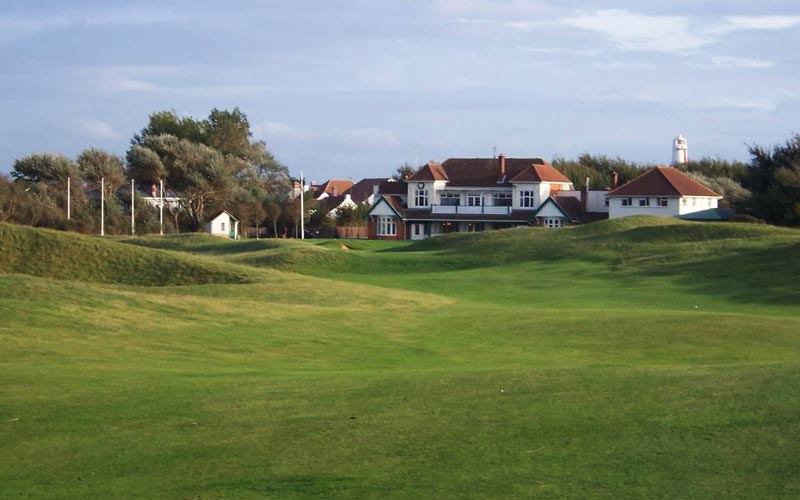
As on the 1st hole, Colt cut a gap through the dune to make the home green visible for well placed drives.
Burnham & Berrow remains one of the elite links of England not because it is the host of important amateur events, but because of the extent for which it serves as a subject for spirited dialogue. The boundless variety of Burnham’s linksland allows the natural hazards of humps, hollows, ridges, valleys and noble sandhills to come fully into play. It may be the case that many modern golfers eschew Burnham because of its reliance on natural hazards which results in awkward lies and blind shots, but enthusiasts of links golf expect and appreciate the opportunity to play cunning scuttles or wristy flops as the situation demands. Surely there are better courses, but few offer the allusive character of Burnham, which make golf courses enthralling fields of play.
Acknowledgements
As I am not by nature a writer of merit, I am grateful to Mark Rowlinson and Anthony Pioppi for guiding my pen. Thanks must go to James Boon and particularly Philip Young for their generous editorial assistance. Dr Richards and Mr A.J. Hill were very helpful in responding to my many queries concerning the flotsam and jetsam of Burnham. As ever, I am deeply indebted to my wife Julia, who is always on hand to answer pressing questions of any nature.
Selected Bibliography
B. Darwin: The Golf Courses of the British Isles
B. Darwin: The Times 13 September 1930
J. Finegan: A Golfer’s Pilgrimage to England and Wales
For information on Majuba see: http://www.britishbattles.com/first-boer-war/majuba-hill.htm & http://samilitaryhistory.org/vol052gr.html
P. Richards: Between the Church and the Lighthouse
D. Steel: Classic Golf Links of Great Britain and Ireland
The End



